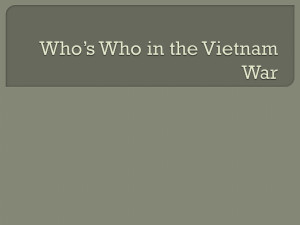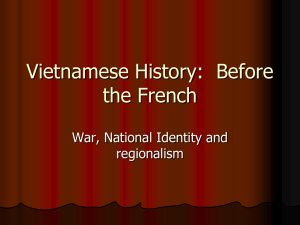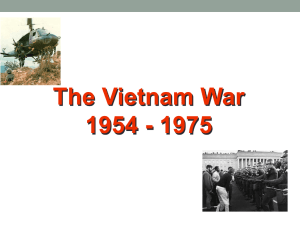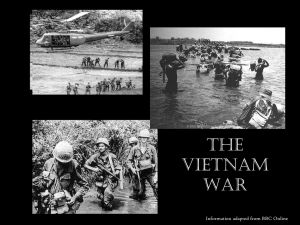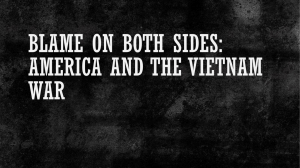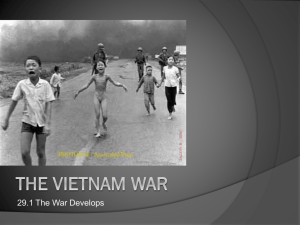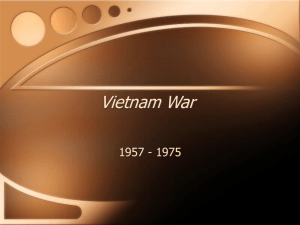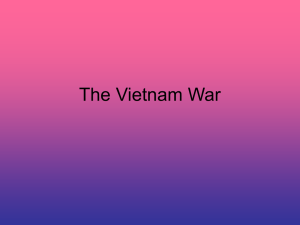Vietnam powerpoint
advertisement
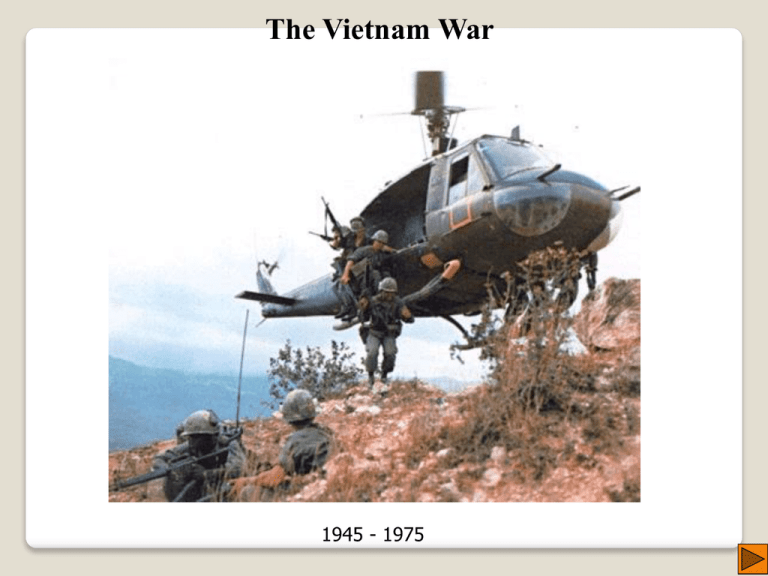
The Vietnam War 1945 - 1975 The Vietnam War - A Background Ho Chi Minh Nationalist who created the Viet Minh to fight the French colonists and then the Japanese. 1945 Ho Chi Minh declares Independence for Vietnam fails to receive United States support for Independence 1) Ho Chi Minh was a communist (Why?) 2) The alliance between the Soviets and the United States had broken down into a “Red Scare” Truman sees a need to fend off the “Red Tide” of communism - Needed French support of NATO in Europe 1950 Truman decides to support the French against the communists A War for National Liberation from French Rule Empowered in part from Vietminh role in fighting the Japanese Expectations from the Atlantic Charter War of the “elephant and the grasshopper” French jaunissement (yellowing) demonstrates a desire to leave Vietnam Very unpopular in France Defeat at Dienbienphu seals the French fate I. First Indochina War, 19451954 French and the Vietminh Divides Vietnam into Two-halves along the 17th parallel Elections were to be held in 1956 to unite the country. They never were, Why? What roles did countries other than France and the Vietminh play at the conference? Prime Minister Diem rejected the Accord and predicted “another more deadly war” to which he would be correct. 1954 Geneva Accords Diem’s Presidency, 1955-1963 •Create support for Diem’s government (Lansdale) •Remove rural support away from the Vietcong (Strategic Hamlets) •Build and train a strong South Vietnamese Army (ARVN) II. The Rise and Fall of Prevent the “Domino Theory” from taking place in South East Asia America’s Mandarin Diem with Eisenhower The infamous failure of Strategic Hamlets Why did they fail? Why was Diem and South Vietnam Important to America? Diem has got to go! 2 October -NSC Meeting 519 - Between President Kennedy, Robert McNamara and Maxwell D. Taylor They brief the President on the trip to South Vietnam (SVN) and discuss the removal of 1,000 advisers from SVN. The President convenes the National Security Council on the matters contained in the report and stresses that the US needed to find effective ways of persuading Diem to change the political atmosphere in Saigon. The President endorses the withdrawal of 1,000 advisers from Vietnam by December 31, 1963. Why were Lansdale’s efforts to make Diem popular unsuccessful in the long-run? Madame Ngo Nhu, the wife of Diem's brother, refers to the immolations as "barbecues". The role of the Cold War 1959 – Marxist Cuban Revolution- Fidel Castro 1960 - The U2 Spy Plane Incident-Francis Gary Powers 1961 - JFK becomes President, January 20 1961 – The failed Bay of Pigs Invasion of Cuba, 1962 - The Cuban Missile Crisis 1963 – President Diem of South Vietnam is assassinated, Kennedy decides to remove all military advisors from Vietnam Quotes from the conflict “to see sovereign rights and self-government restored to those who have been forcibly deprived of them” Atlantic Charter, 1941 “You can kill ten of my men for every one I kill of yours. But even at those odds, you will lose and I will win.” – Ho Chi Minh. “ Communist guerilla hide among people. If you win the people over to your side, the communist guerillas have no place to hide. With no place to hide you can find the. Then military men will fix them…finish them.” Edward Lansdale “[E]very quantitative measurement… shows that we are winning the war.” – Robert McNamara “Now we have a problem in making our power credible, and Vietnam is the place.” –Kennedy “did you really mean it (referring to a compliment about Diem being An Asian Churchill)…… “shit”…. “Diem is the only boy we got out there”- Vice President, Lyndon Johnson. “ The Communists will defeat us, not by virtue of their strength but because of our weakness. They will win by default.” Diem III. Johnson’s War, 1964-1969 The Gulf of Tonkin Incident (Video) 1964 The US Destroyer Maddox is fired upon by the North Vietnamese The Gulf of Tonkin Resolution “Open aggression on the high seas” President Johnson asks for, and gets, wide-ranging powers from Congress to conduct the war in Vietnam Walt Rostow “We don’t know what happened, but it had the desired effect” Operation Rolling Thunder On Mar. 2, 1965, the United States instituted its famous "Rolling Thunder" campaign, the systematic bombing of North Vietnam, starting at the Demilitarized Zone (DMZ) between North and South Vietnam. Its planes flew from bases in South Vietnam and Thailand. By slowly advancing the target areas northward across North Vietnam, it was hoped the North Vietnamese leaders would eventually be convinced to sit down at the peace table. However, Washington imposed stringent controls upon these operations, lest Red China or the Soviet union actively enter the conflict. Winning the Hearts and Minds of the Vietnamese people The US in Vietnam is involved in two simultaneous and very difficult tasks, nation building and fighting a vicious and well-organized enemy. If it could do either one alone, the task would be vastly simplified, but its got to do both at once . . . Helping Vietnam . . . may very well be the most complex problem ever faced by men in uniform anywhere on earth. Program for the Pacification and Long-Term Development of South Vietnam (PROVN) March, 1966 Winning the Hearts and Minds of the Vietnamese people Pacification Program’s limitations The Ho Chi Minh Trail It was located in Laos and Cambodia, both neutral countries during the conflict The Ia Drang Valley, Nov 1965 What did each side learn from this relatively large battle? 7th Cavalry Air-Mobile New style of fighting: Highly mobile, smaller military units 1966 The Big Build-Up Search and Destroy Missions 5,000 Americans died in that year An additional 200,000 men would be sent to Vietnam The Vietcong The Draft Draftees comprised 1/3 of all U.S. soldiers in Vietnam The average age of U.S. soldiers in Vietnam was 19 years LBJ visits troops going to Vietnam in 1966 President Johnson would commit hundreds of thousands of United States military soldiers to Vietnam 550,000 American troops would be in Vietnam when he left the presidency Agent Orange (powerful dioxin) How did the use of technology affect the outcome of the Vietnam War? Notable technological weaponry: B-52 Heavy Bombers, Helicopters, Napalm, Agent Orange, etc What about non-lethal technology? The Television The use of technology Assessment of the War in 1967 Winning or Losing Civil War or Cold War Stay in or get out – Political Cost? What is the cost, is it worth the cost? What was the political, economic and social impact on America during Johnson’s presidency? The Tet Offensive - January 1968 1968 - U.S. involvement peaks at 543,000 troops A massive Vietcong and NVA assault on American positions throughout South Vietnam - (Turning Point event of the war) United States military turns back the attack, but the damage had already been done to the support back home Anti-War Movement The Tet Offensive failed to meet its main goal AND the Vietcong suffered terrible losses. Why then is it a turning point of the war in favor of the North? 1. The United States had set up high expectations for the war to be over soon 2. American support for the war begins to slowly erode and anti-war protestors become more vocal and visible Siege of Khe Sanh “An American Dien Bien Phu? The Election of 1968 Presidential Candidate Robert F. Kennedy assassinated in Los Angeles (June) Hubert Humphery nominated as the Democratic Presidential Candidate Richard Nixon is elected President *Promises to end the war “with honor” IV. Nixon’s War, 1969-1973 The Process of Vietnamization begins Sees the war from the perspective of “Linkage” with the wider Cold War • Failure to pressure the Soviet Union and China to help force the North Vietnamese to accept negotiation demonstrates the folly of “Linkage” • Secret negotiations are begun between Le Duc Tho and Henry Kissinger, but Kissinger fails to get acceptance for the formula of “Mutual Withdrawal” • Nixon simultaneously begins the withdrawal of American troops while widening The war with the secret bombing of Cambodia and later invasion of Cambodia • Kissinger eventually changes the offer to the North to a “Leopard Spot” Agreement. Building on the “stand-still, cease fire”. •The United States forces the South to agree “the tail doesn’t wag the dog” •Nixon resorts to large-scale bombing of the North when they threaten to Not sign. The Christmas 1972 Bombings force the North to sign. My Lai Massacre Occurs March 16, 1968, but revealed to public in 1969 Lt. William Calley orders his men to enter the village firing Over 300 unarmed civilians, many women and children are murdered Calley was eventually convicted of murder, but was later released in 1974 Vietnamization Process of shifting the burden of the war over to the South Vietnamese Army (ARVN) 1970 Nixon expands the war into Cambodia with secret and illegal bombing of Cambodia followed by an invasion With US and South Vietnamese troops Hoped to destroy the Ho Chi Minh Trail May 4, 1970 Protests erupt and tragedy hits Kent State University 4 students are killed by National Guardsmen Pentagon Papers (1971) Daniel Ellsberg leaks 7000 documents to the New York Times and Washington post Why? “I felt that the country was eating its young” Three effects 1. Illustrates government’s lying about war’s progress 2. Illustrates the folly of ESCALATION 3. Creates a paranoid Nixon Administration Patriot or Traitor? The First Televised War Americans begin to question the war “Hawks vs. Doves” 1972 - Jane Fonda visits North Vietnam Operation Linebacker I and II The Christmas Bombings Forces the North Vietnamese to accept Paris Peace Accords South Vietnam remains a non-communist nation, but NLF (Vietcong) are allowed to remain under the “Leopard Spot” agreement What problems did Nixon inherit from the Johnson administration’s conduct of the war? In what ways were the Johnson and Nixon wars similar and different? To what extent did Nixon accomplish his goal of “peace with honor’? Time became the biggest concern for Nixon and his effort to end the war Paris Peace Accords are signed in 1973 South Vietnam retains its independence from the North 1975 - The North will invade the South one last time and succeed in unifying all of Vietnam - * The US does not honor its pledge to protect the South The Aftermath of the Vietnam War Agent Orange Posttraumatic Stress Disorder Americans are forever changed The Cost 110,00 Billion Dollars 58,000 American lives Estimates as high as 3.5 million Vietnamese died in the 30 year conflict 70 Tons of bombs for every square mile - 500 pounds of explosives For every man, woman, and child in the country “Today, Americans can regain a sense of pride that existed before Vietnam. But it can not be achieved by re-fighting a war that is finished…These events. As tragic as they are, portend neither the end of the world nor of America’s Leadership in the world.” April 23, 1975, President Ford The reluctance of the American people to support or allow their government to use military force abroad V. Vietnam Syndrome 1973 to 1991 The Vietnam War Memorial Washington D.C. Contains the names of all those who gave their lives during the Vietnam War
